Class 10 Science Biology Chapter 14 MCQ With Answers
Biology Class 10 Chapter 14 MCQs On Sources of Energy
Sources Of Energy Class 10 MCQ Question 1.
Which of the following is a non-renewable source of energy?
(a) Wood
(b) Sun
(c) Fossil fuels
(d) Wind
Answer:
(c) Fossil fuels
Explanation: Non-renewable sources are those sources that are present in a limited amount and once finished cannot be renewed again for millions of years.
Wood comes from trees, so it is a renewable source of energy. The Sun and wind are also renewable sources of energy but fossil fuels are non-renewable (conventional sources). Once they are used up, they can’t be renewed again, so we need to conserve them.
Towards Green Energy Class 10 MCQ Question 2.
In a hydropower plant:
(a) the potential energy possessed by stored water is converted into electricity
(b) the kinetic energy possessed by stored water is converted into potential energy
(c) electricity is extracted from water
(d) water is converted into steam to produce electricity
Answer:
MCQ On Sources Of Energy Question 3.
Ocean thermal energy is due to:
(a) energy stored by waves in the ocean
(b) temperature difference at different levels in the ocean
(c) pressure difference at different levels in the ocean
(d) tides arising in the ocean
Answer:
![]()
Source Of Energy Class 10 MCQ Question 4.
The major probLem in harnessing nuclear energy is how to:
(a) split nuclei?
(b) sustain the reaction?
(c) dispose off spent fuel safely?
(d) convert nuclear energy into electrical energy?
Answer:
Class 10 Science Chapter 14 MCQ Question 5.
Which part of the solar cooker is responsible for the greenhouse effect?
(a) Coating with black coLour inside the box
(b) Mirror
(c) Glass sheet
(d) Outer cover of the solar cooker
Answer:
(c) Gloss sheet
Explanation: Sotar cookers are covered with a glass plate which traps infrared radiations (heat) from sunlight and does not allow them to escape. In other words, we can say that it provides a greenhouse effect. Solar cookers achieve a higher temperature by using mirrors to focus the rays of the Sun.
Related Theory
The trapping of heat in the environment due to the presence of greenhouse gases like CO2, methane, water vapour etc. causes the greenhouse effect. This raises the temperature of Earth.
MCQs On Sources Of Energy Question 6.
The main constituent of biogas is:
(a) methane
(b) carbon dioxide
(c) hydrogen
(d) hydrogen sulfide
Answer:
(a) methane
Explanation: Biogas is an excellent fuel as it contains up to 75% methane. It burns without smoke, leaves no residue like ash in wood. charcoal and coal burning. Its heating capacity is high. It is also used for lighting.
Sources Of Energy MCQ Question 7.
The power generated in a windmill:
(a) is more in the rainy season, since damp air would mean more air mass hitting the blades
(b) depends on the height of the tower
(c) depends on wind velocity
(d) can be increased by planting tall trees close to the tower
Answer:
Source Of Energy MCQ Question 8.
Choose the correct statement:
(a) The Sun can be taken as an inexhaustible source of energy
(b) There is infinite storage of fossil fuel inside Earth
(c) Hydro and wind energy plants are non-polluting sources of energy
(d) Waste from a nuclear power plant can be easily disposed off
Answer:
![]()
MCQ Of Sources Of Energy Class 10 Question 9.
In a hydroelectric power plant, more electrical power can be generated if waterfalls from a greater height because:
(a) its temperature increases
(b) larger amount of potential energy is converted into kinetic energy
(c) the electricity content of water increases with height
(d) more water molecules dissociate into ions
Answer:
Ch 14 Science Class 10 MCQ Question 10.
The biggest source of energy on Earth’s surface is:
(A) Biomass
(B) Solar radiations
(C) Tides
(D) Winds
Answer:
Sources Of Energy MCQ Class 10 Question 11.
Which is the type of system where the energy is harnessed by the heat accumulated on the surface of the water?
(a) Wind energy
(b) Wave energy
(c) Ocean thermal energy conversion
(d) Solar energy
Answer:
(c) Ocean thermal energy conversion
Explanation: Absorption of heat from the sun by the seas and oceans, solar radiation causes ocean currents and moderate temperature gradients from the water surface downward especially in tropical waters.
MCQ Of Chapter 14 Science Class 10 Question 12.
The correct energy conversion taking place in a hydroelectric power plant is:
(a) Potential energy of water → Kinetic Energy of turbine → Electrical energy
(b) Potential energy of turbine → Kinetic Energy of water → Electrical energy
(c) Heat energy of water → Kinetic Energy of turbine → Electrical energy
(d) Potential energy of water → Heat Energy → Electrical energy
Answer:
![]()
MCQ Questions On Sources Of Energy Class 10 Question 13.
Which of the following are non-conventional sources of energy:
(I) Wind energy
(II) Water
(III) Solar energy
(IV) Geothermal energy
(a) Both (I) and (II)
(b) Both (II) and (III)
(c) Both (III) and (IV)
(d) Both (II) and (IV)
Answer:
Chapter 14 Science Class 10 MCQ Question 14.
Approximately what percentage of energy requirement in India is met by hydropower plants?
(a) 10 %
(b) 25 %
(c) 50 %
(d) 75 %
Answer:
(b) 25 %
Explanation: A quarter or 25 % of the energy requirement in India is met by hydropower plants. But we are still largely dependent upon coal and petroleum for meeting our energy requirements.
Class 10 Sources Of Energy MCQ Question 15.
The table below lists the sources of energy and whether they are exhaustible or non-exhaustible. Select the row containing incorrect information:
| Source of energy | Whether exhaustible or non- exhaustible |
| (a) Fossil fuel | Exhaustible |
| (b) Wind | Non-exhaustible |
| (c) Water | Exhaustible |
| (d) Solar | Non-exhaustible |
Question 16.
Two fuels obtained from biomass are:
(a) Coal and biogas
(b) Petroleum and natural gas
(c) Charcoal and biogas
(d) Charcoal and natural gas
Answer:
(c) Charcoal and biogas
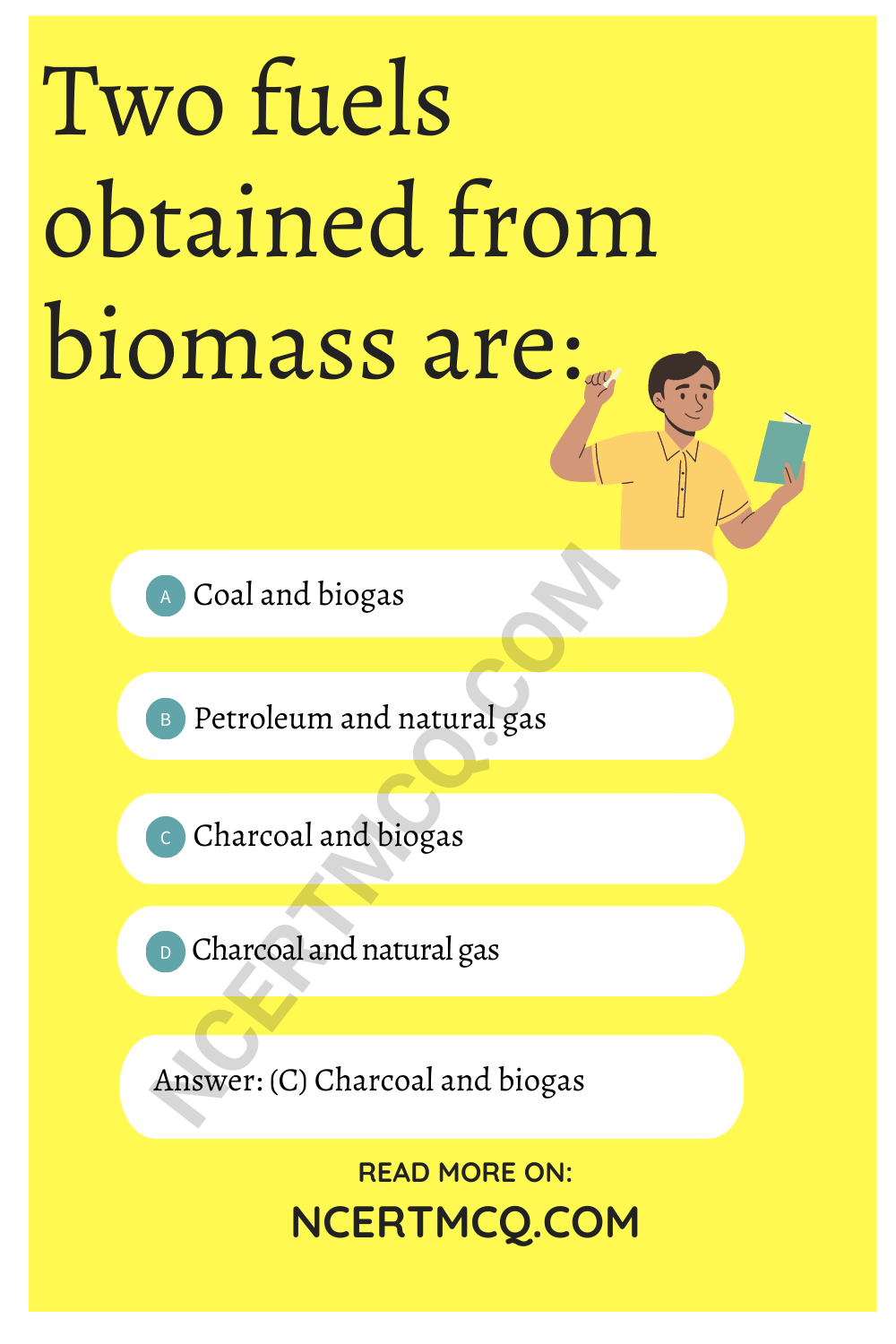
Explanation: When wood is burnt in a limited supply of oxygen, water and volatile materials present in it get removed and charcoal is left behind as the residue. Charcoal burns without flames is comparatively smokeless and has a higher heat generation efficiency. Similarly, cow-dung, various plant materials like the residue after harvesting the crops, vegetable waste and sewage are decomposed in the absence of oxygen to give biogas.
Assertion Reasoning questions Class 10 Science Chapter 14
For the following questions, two statements are given one labeled Assertion (A) and the Other labeled Reason (R). Select the correct answer to these questions from the codes (a), (b), (c) and (d) as given below:
(a) Both (A) and (R) are true and (R) is the correct explanation of the assertion.
(b) Both (A) and (R) are true, but (R) is not the correct explanation of the assertion.
(c) (A) is true, but (R) is false.
(d) (A) is false, but (R) is true.
Question 17.
Assertion (A): In a wind energy farm, a number of windmills are erected over a large area.
Reason (R): The output of a single windmill is quite small and cannot be used for commercial purposes.
Answer:
(a) Both (A) and (R) are true and (R) is the correct explanation of the assertion.
![]()
Question 18.
Assertion (A): All exhaustible sources of energy are non-renewable.
Reason (R): Energy sources that cannot be regenerated are called renewable sources of energy.
Answer:
(Competency Based Questions (CBQs))
Question 1.
Geothermal energy is the energy produced by the heat of molten rocks formed in the deeper hot regions of the earth’s crust. This energy is harnessed to generate electricity. When water is made to flow deep underground in the rocks it returns as steam (or hot water, which is later converted to steam) to drive a turbine on an electric power generator.
In India, exploration and study of geothermal fields started in 1970. The Geological Survey in India has identified 350 geothermal energy locations, in the country. The most promising of these is in Puga Valley of Ladakh. The estimated potential for geothermal energy in India is about 10000 MW. There are seven geothermal provinces in India namely the Himalayas, Sohna, West coast, Cambay, Son- Narmada-Tapi; Godavari and Mahanadi. Most power stations in India produce Alternating Current (A.C).
(A) What are geothermal energy hot-spots?
Answer:
Though the total energy stored in the earth is very vast, but geothermal energy can be harnessed only in particular areas. The particular areas where geothermal energy can be harnessed are called geothermal hot spots.
(B) Name two countries, other than India, where power plants based on geothermal energy are operational.
Answer:
(C) Name the phenomenon that explains the working of an electric generator.
Answer:
Electromagnetic induction is the phenomenon that explains the working of an electric generator.
Explanation: An electric generator is a machine which converts mechanical energy into electrical energy. The phenomenon of electromagnetic induction can be seen as:

The phenomenon of generation of an electric current in a circuit from magnetic effects is called electromagnetic induction.
(D) State an important advantage of using AC over DC.
Answer:
An important advantage of using AC over DC is that electric power can be transmitted over long distances without much loss of energy.
Related Theory
The frequency of AC in India is 50 Hz. DC always flows in one direction, whereas AC reverses its direction periodically. AC can also be changed to DC whenever required
![]()
Question 2.
Acid rain as the name suggests can be said to be the precipitation of acid in the form of rain in the simplest manner. Taj Mahal, one of the 7 wonders of the world, is Largely affected by acid rain.
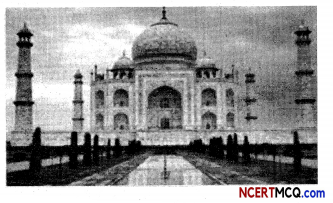
Acid rain happens because:
(a) the Sun causes the heating of the upper layer of atmosphere
(b) the burning of fossil fuels releases oxides of carbon, nitrogen and sulphur in the atmosphere
(c) electrical charges are produced due to friction amongst clouds
(d) Earth atmosphere contains acids
Answer:
(b) the burning of fossil fuels releases oxides of carbon, nitrogen and sulphur in the atmosphere
Explanation: The oxides of carbon, nitrogen and sulphur that are released on burning fossil fuels are acidic oxides. These lead to acid rain, which affects our water and soil resources.
Related Theory
The activities (polluting the atmosphere by industrial exhausts), as well as natural phenomena (emission of volcanos), cause acid rain due to the above mentioned oxides that are released.
Question 3.
Solar power in India is a fast developing industry. The country’s solar installed capacity reached 30.071 GW as of 31 July, 2019. India has the lowest capital cost per MW to install solar power plants. Solar electricity generation recorded nearly 3.4% of total utility electricity generation in January 2019. The following table shows Annual Solar Power Generation of the last six years.
|
Year |
Solar Power Generation(TWh) |
| 2013-14 | 3.35 |
| 2014-15 | 4.60 |
| 2015-16 | 7.45 |
| 2017-18 | 25.87 |
| 2018-19 | 39.27 |
Our country is lucky to receive solar energy for the greater part of the year. It is estimated that during a year India receives the energy equivalent to more than 5000 trillion kWh from the Sun.
(A) What are solar cells?
Answer:
Solar cells are devices which convert Solar energy (Sun’s energy) directly into electricity. A solar cell is also known as a solar photovoltaic (SPV) cell.
Related Theory
A solar cell is made of element silicon. It consists of square piece of silicon. The electric power generated by a single solar cell is very small. So a number of cells are joined together to form a solar panel.
(B) How much voltage can be developed and how much electricity can be produced by one typical solar cell when exposed to the Sun?.
Answer:
One typical cell produces a voltage of 0.5V-1V and can produce about 0.7 W of electricity when exposed to the sun.
Related Theory
Solar devices like solar cooker, solar geyser etc. also use solar energy but can be used only at certain times during the days. This limitation was overcome by combining solar cells in an arrangement called solar cell panel
(C) The future of power generation by solar energy is bright in India. Give reason.
Answer:
(D) List two advantages of solar cells.
Answer:
Advantages of solar cells: The solar cells
- have no moving parts, require little maintenance and work satisfactorily without the use of any focusing device.
- can be set up in remote and inaccessible area or very sparsely inhabited arons
Question 4.
Thermal power plants have been in operation since quite some time. Bharat Heavy Electricals (BHEL) has commenced civil works at 660 MW Sagardighi supercritical thermal power project in the state of West Bengal. BHEL is a manufacturer of power generation equipment with an installed base of over 1,90,000 MW power plant equipment globally.
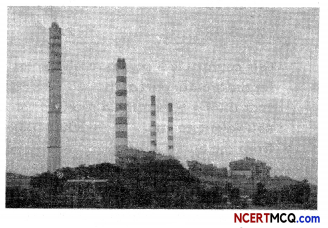
The fuel used in thermal power plants is:
(a) water
(b) uranium
(c) biomass
(d) fossil fuels
Answer:
Question 5.
Renewable energy sources such as wind energy are vital for the Indian economy, not only from the point of view of supply, but also from the perspective of environmental and social benefits. India is the world’s fifth largest wind-power producer and the largest windmill facilities in India are installed in Tamil Nadu. Muppandal is a small village of Tamil Nadu and one of the most important sites of wind-farm in the state. It uses wind from the Arabian Sea to produce renewable energy. The suitability of Muppandal as a site for wind farms stems from its geographical location as it has access to the seasonal monsoon winds.
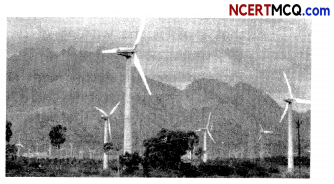
The electrical generators used on wind turbines in sites like Muppandal, produce an output AC of 240 V and a frequency of 50 Hz even when the wind speed is fluctuating. A transformer may be required to increase or decrease the voltage so it is compatible with the end usage, distribution or transmission voltage, depending on the type of interconnection.
(A) State the principle behind electric generator.
Answer:
The principle behind electric generator is Electromagnetic Induction- the pheno¬menon of producing current in a coil by changing the magnetic field associated with it.
(B) The output frequency of wind turbine is 50 Hz. What is meant by this statement?
Answer:
The polarity of the output alternating current changes every \(\frac{1}{100}\) seconds.
Alternately:
In 1 second the output (AC) completes 50 cycles.
(C) Why do you think Muppandal is at an advantageous position for this project?
Answer:
(D) Based on the data represented in the graph below, which of the two cities A or B would be an ideal location for establishing a wind-farm and why?
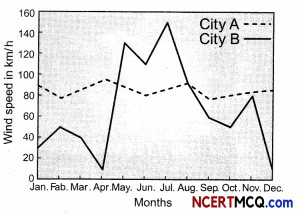
Answer:
City A
It is more suitable for a wind-farm as there is consistently high wind-speed in that city throughout the year.
![]()
Question 6.
A nuclear power plant is a thermal power station in which the heat source is a nuclear reactor. As is typical of thermal power stations, heat is used to generate steam that drives a steam turbine connected to a generator that produces electricity. As of 2018, the International Atomic Energy Agency reported there were 450 nuclear power reactors in operation in 30 countries around the world.
Nuclear power is the fifth-largest source of electricity in India after coal, gas, hydroelectricity and wind power. As of November 2020, India has 22 nuclear reactors in operation in 7 nuclear power plants, with a total installed capacity of 6,780 MW.
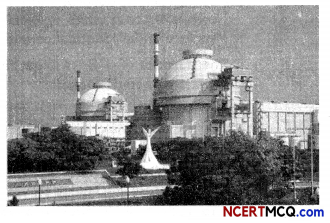
Which one of the following statements is not true about nuclear energy generation in a nuclear reactor?
(a) Energy is obtained by a process called nuclear fission.
(b) The nucleus of Uranium is bombarded with high energy neutrons.
(c) A chain reaction is set in the process
(d) In this process a tremendous amount of energy is released at a controlled rate.
Answer:
(b) The nucleus of uranium is bombarded in the high energy neutrons.
Explanation: In a nuclear reactor, nuclear fission of nuclear fuel takes place to generate nuclear energy. Nuclear energy is released when nueleus of uranium is bombarded with low energy neutrons. Hence, this statement (b) is incorrect. All other three statements are correct.
Nuclear fission is the phenomenon of splitting of Uranium (heavy atom) into two medium weight nuclei. When it is bombarded with a slow neutron. A large amount of energy is released. In a nuclear reactor, nuclear fuel is a part of a self sustaining fission chain reaction that releases energy at a controlled rate.
Chain reaction:
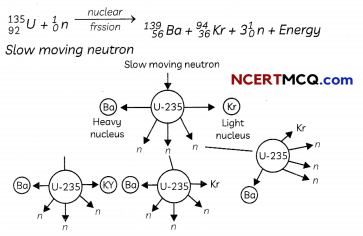
The fission of an atom of uranium produces 10 million times the energy produced by the combustion of an atom of carbon from coal.
Question 7.
The Tehri dam is the highest dam in India and one of the highest in the World. The Tehri dam withholds a reservior of capacity 4.0 km3 and surface area 52 km2. It is used for irrigation, municipal water supply and the generation of 1000 MW of hydro electricity.
The Tehri Dam has been the object of protests. Environment activist Shri Sunder Lai Bahuguna led the ‘Anti Tehri Dam Movement” from 1980s to 2014. The protest was against the displacement of town inhabitants and environmental consequences of the weak ecosystem. The relocation of more than 1,00,000 people from the area has led to protracted legal bat over resettlement rights and ultimately resulted in the delayed completion of the project.
(A) How is hydropower harnessed?
Answer:
(B) Define 1 MW.
Answer:
1 mW is a unit for measuring power (megawatt)
1 mW = 1000 kW 1 kW = 1000 W 1 mW = 106 W
(C) Mention two disadvantages of constructing Tehri Dam.
Answer:
Disadvantages of constructing Tehri Dam:
- Large ecosystems are destroyed when submerged under the water in dams.
- The vegetation which is submerged rots under anaerobic conditions and release a large amount of methane gas which is a green-house gas.
- Large areas of agricultural land is used.
- It creates a problem of satisfactory rehabilitation of displaced people
(D) What happens when water from great heights is made to fall on blades of turbine?
Answer:
When water from great heights is made to fall on blades of turbine, the potential energy of the water changes into kinetic energy which is transferred to the turbine. Moving turbine rotates the armature of a generator and kinetic energy of water changes to electricity.
![]()
Question 8.
Take two conical flasks and paint one white and the other black. Fill both with water. Place the conical flasks in direct sunlight for half an hour to one hour. Touch the conical flasks. You could also measure the temperature of the water in the two conical flasks with a thermometer.
Next, study the structure and working of a solar cooker and/or a solar water-heater, particularly with regard to how it is insulated and maximum heat absorption is ensured. Design and build a solar cooker or water- heater using low-cost material available and check what temperatures are achieved in your system.
(A) In the first activity, two conical flasks, one painted white and the other black, are filled with water and then placed in direct sunlight, for half an hour. Select the correct observation regarding their temperature:
(a) Both the conical flasks will be equally hot.
(b) The conical flask painted black will be hotter.
(c) The conical flask painted white will be hotter.
(d) The conical flask painted white will absorb more heat
Answer:
(b) The conical flask painted black will be hotter.
Explanation: The conical flask painted black will be hotter as compared to the flask painted white as a black surface absorbs more heat as compared to a white or a reflecting surface under identical conditions.
(B) The parts of a box – type solar cooker is given below. Select the row containing incorrect information.
|
Part |
Description |
| (a) Black box | An insulated metal, or wooden box which is painted white from the inside to radiate more heat. |
| (b) Glass cover | Made of two sheets of toughened glass held together in an aluminium frame. |
| (c) Plane Mirror | Plane mirror is fixed to the box with the help of hinges and it acts as a reflector |
| (d) Cooking Containers | A set of aluminium containers blackened from the outside are kept in the box |
Answer:
(C) The property used by solar cookers and solar water heaters is:
(a) A reflector absorbs more heat as compared to a white surface under identical conditions.
(b) Black surface reduces loss of heat by radiation.
(c) White surface absorbs more heat as compared to a reflecting surface under identical conditions.
(d) Black surface absorbs more heat as compared to a white or a reflecting surface under identical conditions.
Answer:
(d) Black surface absorbs more heat as compared to a white or a reflecting surface under identical conditions.
(D) The purpose of a glass sheet fixed on the box of the solar cooker is:
(a) To focus sun’s radiations at one point.
(b) To absorb maximum heat of the sun’s rays.
(c) To prevent heat from escaping escape from the cooker box.
(d) To reflect sun’s rays towards the cooker box.
Answer:
(E) Which of the following is not a limitation of solar cooker?
(a) Some solar cookers take longer to cook food than a conventional stove or an oven.
(b) Reduces carbon footprint by cooking without carbon dioxide-based fuels.
(c) It can be used only at certain time of the day.
(d) It cannot be used during nights and rainy days.
Answer:
(b) Reduces carbon footprint by cooking without carbon dioxide-based fuels.
Explanation: As solar cooker uses only solar energy, there is no pollution caused as it does not use carbon dioxide based fuels and hence carbon footprint is reduced.
Question 9.
When Poorva visited Bengaluru along with her parents, she noticed that most houses had solar panels installed on their roof top. However, despite their ability to generate clean, green electricity, solar panels aren’t as commonplace as the could be. The main sticking point, of course, is price. Due to their need for relatively expensive semiconductor materials, conventional solar cells don’t yet have a price-efficiency combination that can compete with other sources of electricity. A conventional solar cell is made of a thin wafer of a semiconductor with a metallic electrode deposited on its rear side.
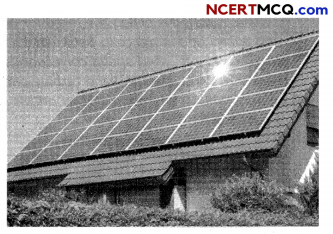
The values of voltage developed in a solar cell and power of a solar cell when exposed to electricity are given in the following table. Select the row containing the correct values:
|
Voltage Developed in a Solar Cell |
Power Produced in a Solar Cell |
| (a) 0.7 V | 0.5-1.0 kW |
| (b) 0.5-1.0 V | 0.7 W |
| (c) 5-10 V | 0.7 kW |
| (d) 1.5-2.0 V | 7 W |
Answer:
(b) Voltage Developed in a Solar Cell: 0.5 -1.0 V; Power Produced in a Solar Cell: 0.7 W
Explanation: A typical solar cell develops a voltage of 0.5-1 V and can produce about 0.7 W of electricity when exposed to the Sun.
![]()
Question 10.
Discuss in class the question of what is the ultimate source of energy for bio-mass, wind and ocean thermal energy.
Gather information about various energy sources and how each one affects the environment.
Debate the merits and demerits of each source and select the best source of energy on this basis.
(A) The ultimate source of energy for bio¬mass is:
(a) Living organisms
(b) Sun
(c) Water
(d) Earth
Answer:
(b)sun
Explanation: The ultimate source of energy for bio-mass is the sun as these fuels are plant and animal products and plants and animals ultimately depend on sun for their energy needs.
(B) Following statements are given below regarding wind energy and nuclear energy.
Select the incorrect statements:
(I) Wind energy does not contaminate the environment but nuclear energy may contaminate the environment.
(II) Efficiency of wind energy farms is less than that of nuclear plants.
(III) Wind energy farms can be set up anywhere whereas nuclear power plants can be set up only at specific locations.
(IV) Both are non-conventional sources of energy
(a) Both (I) and (II)
(b) Both (II) and (III)
(c) Both (III) and (IV)
(d) (II), (III) and (IV)
Answer:
(c) Both (III) and (IV)
Explanation: The wind energy farms can be set up only at specific locations where wind blows for the greater part of a year and the wind speed should also be higher than 15 km/
(C) Select the correct statement regarding different sources of energy:
(a) Geothermal energy makes use of steam trapped in rocks due to geological changes.
(b) Nuclear energy makes use of chemical reactions between different atoms to produce energy.
(c) Hydroelectricity makes use of gravitational pull of the moon on the spinning earth.
(d) Wave energy makes use of potential energy possessed by the waves.
Answer:
(D) Out of coal, petroleum, solar energy and wind, minimum pollution is caused by:
(a) Coal
(b) Petroleum
(c) Solar energy
(d) Wind energy
Answer:
(E) Which of the following factor does not affect the?
(a) Ease of extracting energy from that source.
(b) Economics of extracting energy from the source and efficiency of the technology available.
(c) Environmental damage that will be caused by using that source.
(d) Has less energy efficiency and more calorific value
Answer:
(d) Has less energy efficiency and more calorific value
Explanation: All the above factors affect the choice of a particular source of energy.
Question 11.
Shaurya visited her paternal village after quite some time. She was pleasantly surprised to see that most of the houses had biogas chulhas at their place as a biogas plant was built by an NGO at the village.
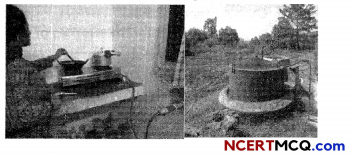
Why is biogas considered an excellent fuel?
Answer:
![]()
Question 12.
Wind power is one of the fastest-growing renewable energy technologies. Usage is on the rise worldwide, because costs are falling. Global installed wind-generation capacity onshore and offshore has increased by a factor of almost 75 in the past two decades, jumping from 7.5 gigawatts (GW) in 1997 to some 564 GW by 2018. Production of wind electricity doubled between 2009 and 2013, and in 2016 wind energy accounted for 16% of the electricity generated by renewables. Many parts of the world have strong wind speeds, but the best locations for generating wind power are sometimes remote ones. Offshore wind power offers tremendous potential.
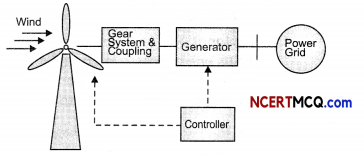
The power curve of a wind turbine is a graph that indicates how large the electrical power output will be for the turbine at different wind speeds. At very low wind speeds, the torque exerted by the wind on the blades is insufficient to bring the turbine to rotate. The wind speed at which the turbine starts to generate electricity is called cut-in or start up wind speed and is typically between 3 and 4 m/s. Above the cut-in wind speed, there is sufficient torque for rotation, and power production increases before reaching a threshold. The lowest wind speed at which the nominal power is reached is called the rated (or nominal) wind speed and is typically between 12 and 17 m/s. The cut-off wind speed corresponds to the maximum wind speed a wind turbine can safely support while generating power and is usually about 25 m/s.
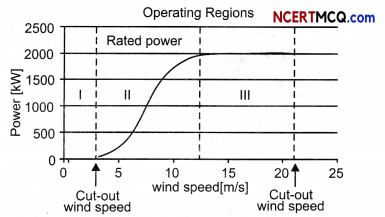
(A) Study the above power graph and select the row containing the correct information:
| Lowest Wind Speed at which the Nominal Power is Reached | Wind Speed at which the Turbine Starts to Generate Electricity | Maximum Wind speed a Wind Turbine can Safety Support while Generating Power |
| (a) 12 m/s | 3 m/s | 22 m/s |
| (b) 3 m/s | 12 m/s | 22 m/s |
| (c) 3 m/s | 22 m/s | 12 m/s |
| (d) 22 m/s | 3 m/s | 12 m/s |
Answer:
(a) Lowest Wind Speed at which the Nominal Power is Reached: 12 m/s ;
Wind Speed at which the Turbine Starts to Generate Electricity : 3 m/s ;
Maximum Wind speed a Wind Turbine can Safely Support while Generating Power: 22 m/s
Explanation: The lowest wind speed at which the nominaL power is reached is called the rated (or nominal) wind speed and is about 12 m/s.
The wind speed at which the turbine starts to generate electricity is called cut-in or start up wind speed and is about 3 m/s.
The maximum wind speed a wind turbine can safely support while generating power is the cut-off speed and is about 22 m/s.
(B) In a water-lifting pump:
(a) The up and down motion of windmill is converted to rotatory motion.
(b) The horizontal motion of windmill is converted to rotatory motion.
(c) The rotatory motion of windmill is converted to horizontal motion.
(d) The rotatory motion of windmill is converted to up and down motion.
Answer:
(d) The rotatory motion of windmill is converted to up and down motion.
Explanation: A water pumping windmill is simple, and efficient. The blades of the windmill wheel catch the wind, which turns the rotor. The wheel assembly is attached to a hub assembly, which drives a geared mechanism that converts the rotary motion to an up-and-down motion. This motion drives a pump rod, up and down inside of a pipe in the well. A cylinder with a sealed plunger going up and down inside forces the water up the pipe.
(C) Select the correct statements regarding wind mills:
(I) The rotatory motion of the windmill is used to turn the turbine of the electric generator.
(II) The output of a single windmill is quite large and can be used for commercial purposes.
(III) A wind energy farm is a large area where a number of windmills are erected.
(IV) The energy output of each windmill in a farm is coupled together to get electricity on a commercial scale.
(a) Both (I) and (II)
(b) Both (II) and (III)
(c) (I), (III) and (IV)
(d) (II), (III) and (IV)
Answer:
(D) Which of these processes explains the extraction of energy from wind to do work?
(a) conversion of mechanical energy of wind into kinetic energy
(b) conversion of kinetic energy of wind into mechanical energy
(c) conversion of mechanical energy of wind into potential energy
(d) conversion of potential energy of wind into mechanical energy
Answer:
(E) The minimum wind speed to maintain the required speed of the turbine is:
(a) 15 km/h
(b) 18 km/h
(c) 20 km/h
(d) 25 km/h
Answer:
Question 13.
Solar power in India is a fast developing industry. India is endowed with vast solar energy potential. About 5,000 trillion kWh per year energy is incident over India’s land area with most parts receiving 4-7 kWh per sq. m per day. Solar photovoltaics power can effectively be harnessed providing huge scalability in India. Solar also provides the ability to generate power on a distributed basis and enables rapid capacity addition with short lead times. Off-grid decentralized and low- temperature applications will be advantageous from a rural electrification perspective and meeting other energy needs for power and heating and cooling in both rural and urban areas. Solar energy has taken a central place in India’s National Action Plan on Climate Change with National Solar Mission as one of the key Missions. Recently, India achieved 5th global position in solar power deployment by surpassing Italy. Solar power capacity has increased by more than 11 times in the last five years from 2.6 GW in March,2014 to 30 GW in July, 2019.
The following graph shows annual solar power generation of the last seven years.
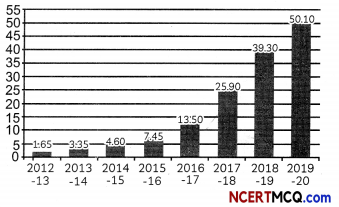
(A) ApproximateLy what percentage of solar energy incident on earth’s outer atmosphere reaches the earth’s surface?
(a)20%
(c)30%
(c)50%
(d)80%
Answer:
(c) 50 %
Explanation: Only a small part of soLar energy reaches the outer layer of the earth’s atmosphere. Nearly half of it is absorbed while passing through the atmosphere and the rest reaches the earth’s surface.
(B) The average solar energy incident over India’s Land area is given in tabLe beLow.
Select the row containing the correct information:
| Solar Energy Incident over India’s Land Area per Year | Average Solar Energy Incident per sq. m per Doy |
| (a) 2500 billion kWh | 40-70 Wh |
| (b) 5000 trillion kWh | 4-7 kWh |
| (c) 500 trilLion kWh | 4-7 Wh |
| (d) 5000 billion kWh | 0.4-0.7 kWh |
Answer:
(b) Solar energy incictent over India’s land Area per year: 5000 trillion kWh: Average solar Energy incident Sq.m per Days 4-7 kWh ”
Explanation: About 5,000 triLlion kWh per year energy is incident over India’s land area with most parts receiving 4-7 kWh per sq. m per day.
(C) Energy conversion taking place in solar cell is:
(a) Solar energy is converted to Chemical energy
(b) Chemical energy is converted to electrical energy
(c) Heat energy is converted to Light energy
(d) Solar energy is converted to electrical energy
Answer:
(D) The advantages of using solar cells are given below. Select the incorrect statements:
(I) They have no moving parts.
(II) They make use of focusing devices for satisfactory performance.
(III) They can be set up in remote areas where laying of a power transmission line may be expensive.
(IV) Special grade silicon used in making solar cells are abundantly available
(a) Both (I) and (III)
(b) Both (I) and (IV)
(c) Both (II) and (III)
(d) Both (II) and (IV)
Answer:
(d) Both (II) and (IV)
Explanation: Solar cells work quite satisfactorily without the use of any focusing devices. Silicon, which is used for making solar cells, is abundant in nature but availability of the special grade silicon for making solar cells is limited.
(E) The substance used for interconnection of cells in solar panel is:
(a) Silver
(b) Gold
(c) Platinum
(d) Copper
Answer:
![]()
Question 14.
Sardar Sarovar Dam (SSD), on the Narmada river, is located in the village of Kevadia in the state of Gujarat. It is one of the largest and most controversial interstate, multipurpose river valley infrastructure development projects in the country. The Sardar Sarovar Project (SSP) also consists of auxiliary works and a 1,450 MW power complex.
SSP was estimated to have cost INR 400bn ($8bn) in 2010-2011, revised from the initial estimate of INR 64bn ($1.25bn) in 1988. It is part of the Narmada Valley Development Project, a major plan to generate power and supply water for drinking and irrigation to states of Gujarat, Madhya Pradesh and Maharashtra. The scheme was conceived by the late Sardar Vallabhbhai Patel in 1946¬1947. It envisages the construction of 30 major dams, 135 medium and 3,000 smaller dams along the river, with SSD being the largest of them all. They are expected to generate about 4,000 MW of power in total.

(A) In hydroelectric power plants:
(a) Kinetic energy is converted to potential energy
(b) Wind energy is converted to solar energy
(c) Solar energy is converted to wind energy
(d) Potential energy is converted to kinetic energy
Answer:
(B) Hydroelectric power plant uses :
(a) Non-renewable source of energy
(b) Non-conventional source of energy
(c) Conventional source of energy
(d) Exhaustible source of energy
Answer:
(c) Conventional source of energy
Explanation: Hydroelectric power plant uses water, which is a conventional source of energy and Hydro power plants convert the potential energy of falling water into electricity. It is a non-exhaustible source of energy as water in the reservoir would be refilled each time it rains.
(C) Given below are statements regarding problems associated with constructions of big dams.
Select the correct statements.
(I) The dams can be constructed only along the river course in plain areas.
(II) Large areas of agricultural land and human habitation are to be sacrificed as they get submerged.
(III) Large eco-systems are destroyed when submerged under the water in dams.
(IV) The submerged vegetation rots and produces large amounts of carbon dioxide, a green house gas.
(a) Both (I) and (II)
(b) Both (II) and (III)
(c) Both (I) and (IV)
(d) Both (III) and (IV)
Answer:
(D) The present installed capacity of the Sardar Sarovar Project is:
(a) 1.450 MW
(b) 1450 kW
(c) 1450 MW
(d) 4000 MW
Answer:
(c) 1450 MW
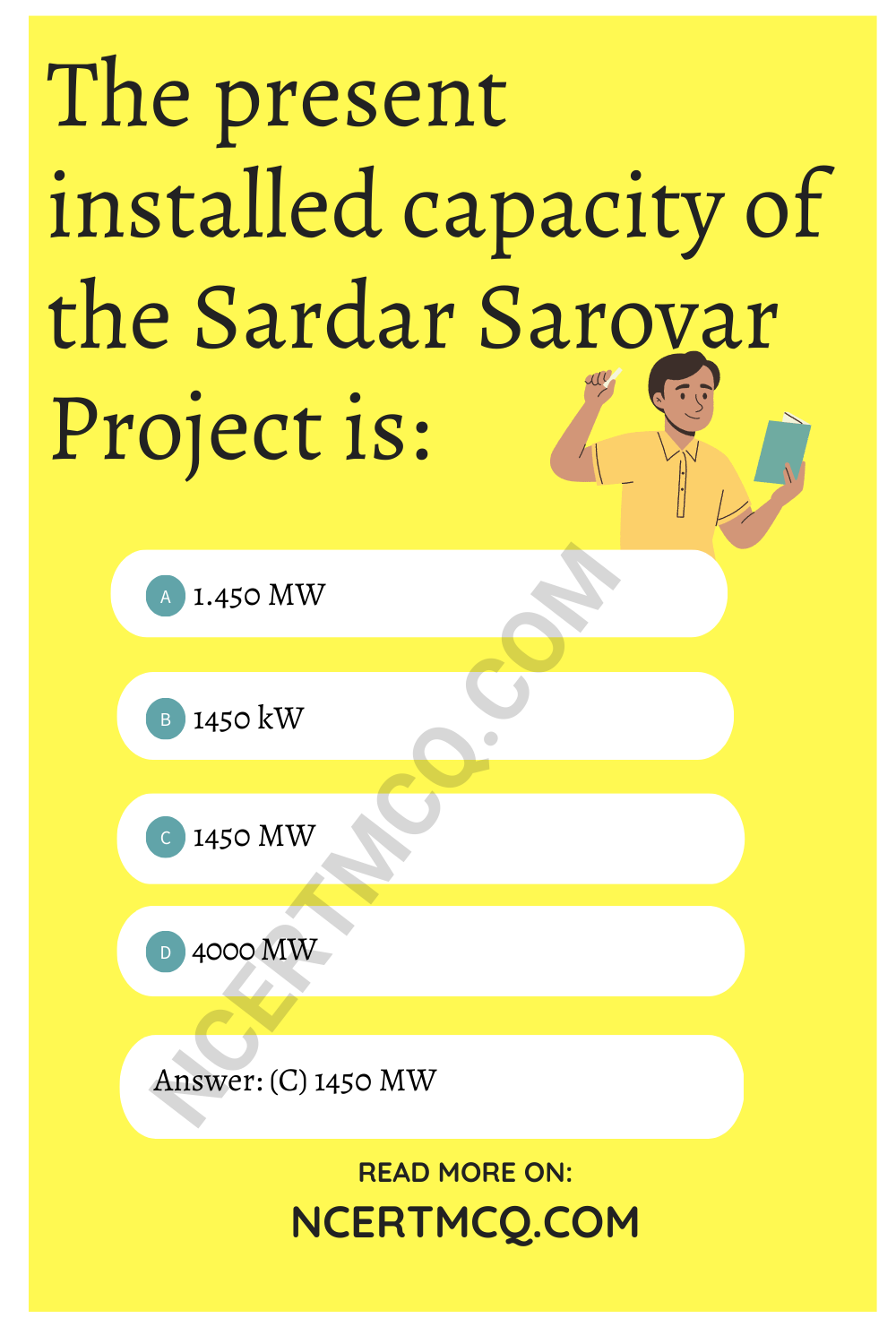
(E) The table below lists the comparison between thermal power plant and hydro power plant. Select the row containing incorrect information:
| Thermal Power Plant | Hydropower Plant |
| (a) Fossil fuels are burned to produce steam which runs turbine | The kinetic energy of water is used to run turbine |
| (b) Set up near coal or oil fields | Set up near oceans |
| (c) Causes pollution | Is pollution free |
| (d) Does not affect ecosystem | Affects ecosystem |
Answer:
(b) Thermal Power Plant: Set up near coal or oil fields; Hydropower Plant: Set up near oceans
Explanation: Thermal power plants are usually set up near coal or oil fields to reduce the cost of transportation of coal or petroleum. In order to produce hydel electricity, high-rise dams are constructed on the river to obstruct the flow of water and thereby collect water in larger reservoirs.
![]()
Question 15.
Nuclear energy can be used to create electricity, but it must first be released from the atom. In the process of nuclear fission, atoms are split to release that energy. A nuclear reactor, or power plant, is a series of machines that can control nuclear fission to produce electricity. The fuel that nuclear reactors use to produce nuclear fission is pellets of the element uranium. Nuclear energy produces electricity that can be used to power homes, schools, businesses, and hospitals. The first nuclear reactor to produce electricity was located near Area, Idaho. The Experimental Breeder Reactor began powering itself in 1951. The first nuclear power plant designed to provide energy to a community was established in Obninsk, Russia, in 1954.
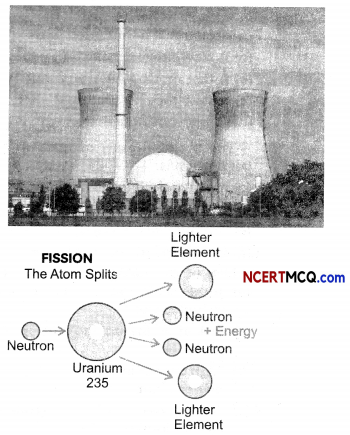
(A) The table below lists the fuel, process involved and principle used for generating nuclear energy. Select the row containing the correct information:

Answer:
(B) Which of the following statements regarding nuclear reactors designed for electric power generation are incorrect?
(I) In a nuclear reactor designed for electric power generation the nuclear fuel undergoes fusion.
(II) A self sustaining chain reaction takes place.
(III) Energy is released at an uncontrolled rate.
(IV) The released energy is used to produce steam and further generate electricity.
(a) Both (I) and (II)
(b) Both (II) and (III)
(c) Both (III) and (IV)
(d) Both (I) and (III)
Answer:
(C) In nuclear fission, a heavy nucleus such as Uranium is bombarded with:
(a) A slow moving neutron
(b) A fast moving neutron
(c) A slow moving proton
(d) A fast moving electron
Answer:
(a) A slow moving neutron
Explanation: In nuclear fission, when a heavy nucleus such as Uranium is bombarded with a slow moving neutron, the nucleus splits into two or more lighter nuclei.
(D) The major hazard of nuclear power generation is:
(a) It produces lot of smoke
(b) Storage and disposal of spent fuels
(c) Limited availability of uranium
(d) Uncontrolled chain reaction
Answer:
(E) Which of the following is not a reason for large scale use of nuclear energy being prohibitive?
(a) Risk of accidental leakage of nuclear radiation.
(b) High cost of installation of a nuclear power plant.
(c) Low risk of environmental contamination
(d) Limited availability of uranium.
Answer:
(c) Low risk of environmental contamination
Explanation: Improper nuclear-waste storage and disposal result in environmental contamination which is one of the reasons for large scale use of nuclear energy being prohibitive.
Question 16.
Koyal was reading about harnessing the energy from the ocean. She read about the OTEC technology which generates electricity from turbines turned by steam produced from heating the warmer surface waters of the sea into steam. The steam is then condensed by the deeper colder waters which are pumped up from depths of around 1000 metres.

What is the operating principal in OTEC systems?
Answer:
The OTEC or Ocean Thermal Energy Conversion systems work on the principle that there is a temperature difference between the water at the surface of the ocean is about 20 k warmer than the water at depths up to 2 km which is used to boil a volatile liquid whose vapours are then used to run the turbine of a generator.
![]()
Question 17.
Wind power is arguably one of the oldest human technologies. Today, wind power is symbolized in most people’s minds by a big, white, monolithic wind turbine. As we try to move into the post-carbon era, it’s worth remembering that only wind, nuclear, and solar have the same technical potential to provide energy as fossil fuels do today. Perhaps the face of future power generation won’t be huge smokestacks, but fields of wind turbines.

What are the factors which limit the use of wind energy?
Answer:
The factors which limit the use of wind energy are that the wind energy farms can be established only at places where wind blows for the greater part of the year and wind speed should also be greater than 15 km/h.
Question 18.
Geothermal energy, form of energy conversion in which heat energy from within the earth is captured and harnessed for cooking, bathing, space heating, electrical power generation, and other uses.Heat from Eorths interior generates surface phenomena such as lava flows, geysers, fumaroles, hot spíings, and mud pots. The heat is produced mainly by the radioactive decay of potassium, thorium, and uranium ¡n Earth’s crust and mantle and also by friction generated along the margins of continental plates.
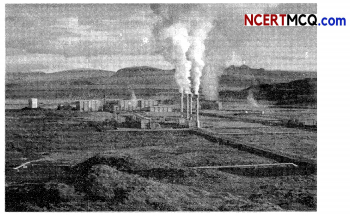
What are hot spots? How are they different from hot springs?
Answer:
Hot spots are the regions in the earth’s crust where molten rocks formed in the deeper hot regions of the earth’s crust are pushed and trapped. Hot springs are the outlets on the surface of the earth from where hot water comes out.
Very Short Answer Type Questions
Question 1.
Name two constituents of biogas.
Answer:
The two constituents of biogas are:
(1) Methane
(2) Carbon dioxide
(3) Hydrogen
(4) Hydrogen sulphide